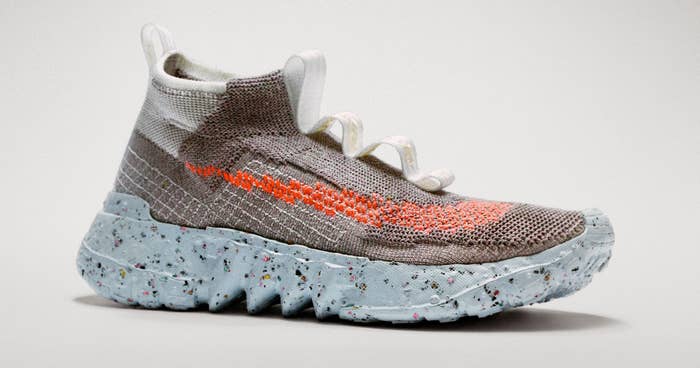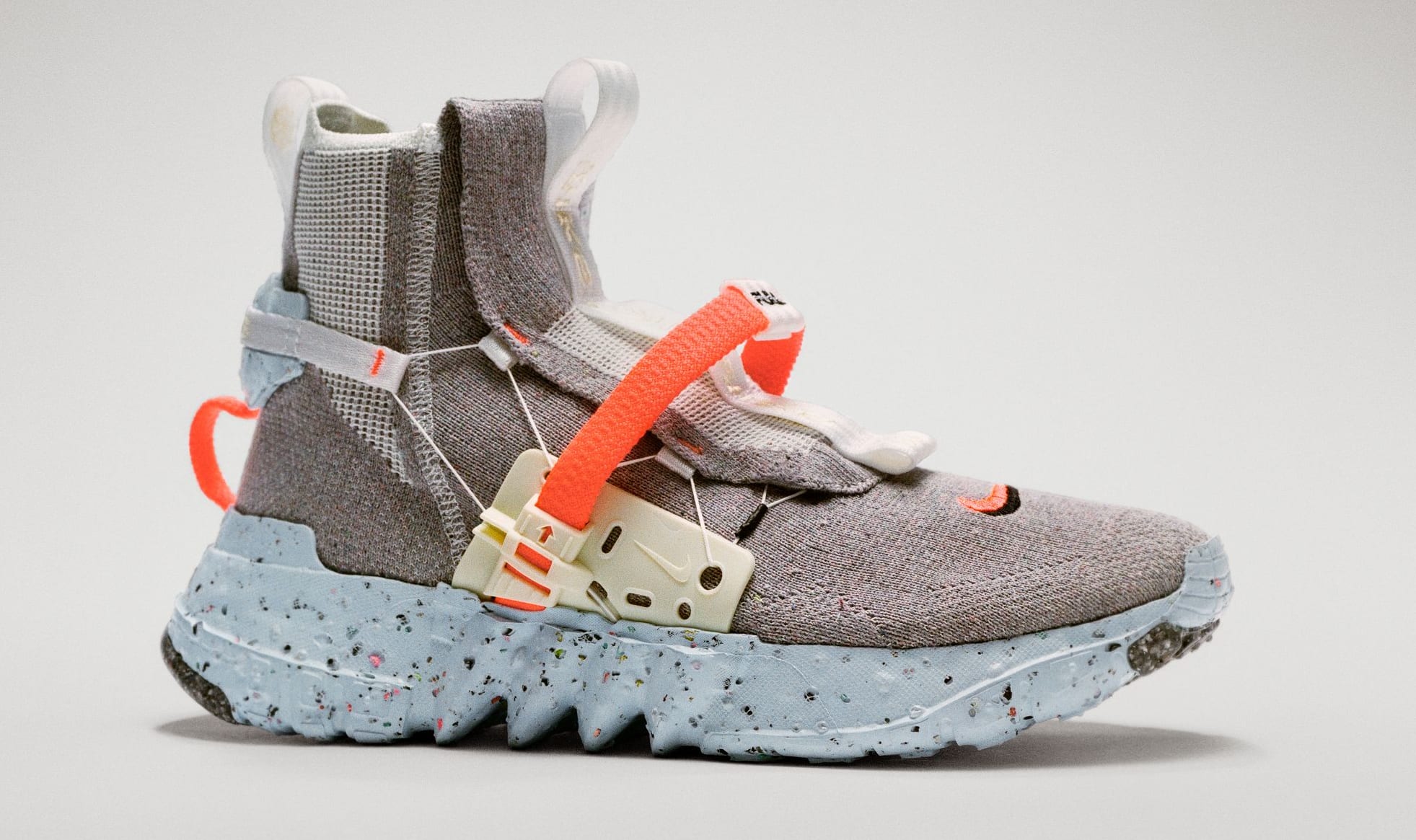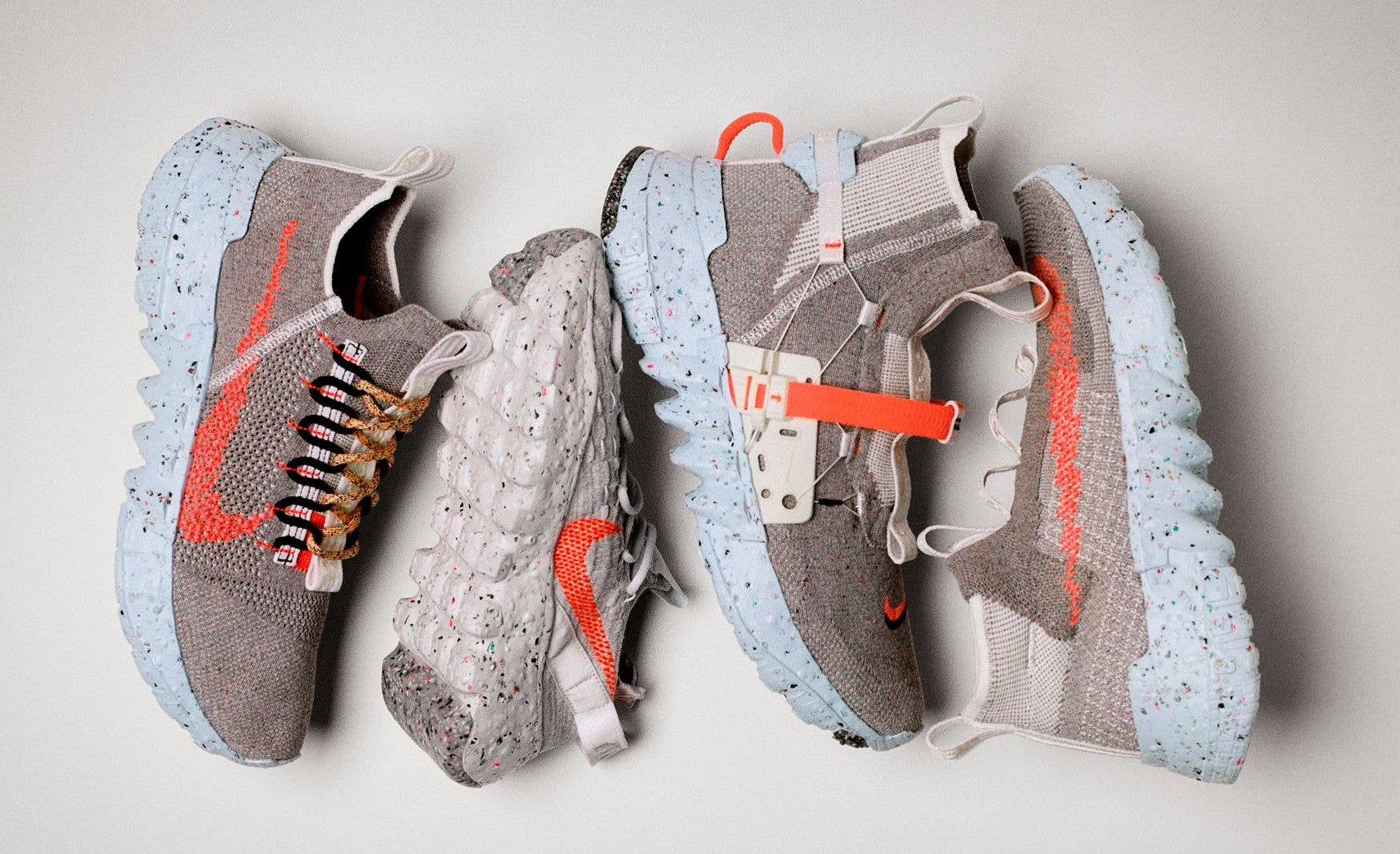
"Is the foam supposed to look like that?" the people in the factory wondered, finding deficiencies. "That's a topline that's messed up. That's a B-grade part."
The shoes' scrappy look would not have passed muster were this a typical Nike product. Here, though, the rough-hewn details were the whole point.
"No, actually, that's an A-grade part," replied Noah Murphy-Reinhertz, the brand's sustainable design lead. "That's perfect."
Nike calls them its Space Hippie sneakers, a group of four models set to release on July 3. There is the low-cut Space Hippie 01 ($130), the more mid Space Hippie 02 ($150), the higher-cut Space Hippie 03 ($180), and the low, women's-only Space Hippie 04 ($130). They are rugged in a way, platformed with a speckled foam that looks like it could have been scraped from a meteorite. The designs represent what Nike says is a radical expression of sustainability: They are its lowest carbon footprint shoes to date.

The chunky soles are housed in what it's calling crater foam, which blends typical Nike foam with 15% recycled rubber. That membrane protects a layer of ZoomX, the bouncy core of the cushioning cake, made from leftover materials from Nike's top-tier running models. On the upper, the shoes have "space waste yarn," made totally from recycled materials like old T-shirts, textile scraps, and plastic bottles.
"I'd say Space Hippie attacks the villain of trash," said John Hoke, Nike's chief design officer, in a Nike News piece in February. "It's changed the way we look at materials, it's changed the way that we look at the aesthetics of our product. It's changed how we approach putting product together."
Even the Space Hippie packaging has a concession for the environment. To the dismay of sneaker resellers, Nike will not double-box the pairs it sells, meaning it may make moving them on the secondary market more difficult if they arrive with shipping labels printed directly on the repurposed cardboard box.
The idea of reusing the limited materials at one's disposal is embedded in the design. The shoes are imagined as the work of an astronaut who can't rely on a resupply mission. Think of them as the sneakers Matt Damon may have made for himself in The Martian, were he not so focused on potatoes. Nike's approach was to bring this idea of being stranded among the heavenly bodies with little to work with back down to Earth, where we are reminded with increasing frequency that we may just be another rock in space with finite materials to draw from.

The approach of making shoes using only what's at your immediate disposal turned out to be darkly prescient. Right when Nike moved to release this product encouraging creation in a closed environment, much of the world's population started staying inside and closing off its environment as much as possible. As the brand prepared to roll out the Space Hippie collection this year, the COVID-19 pandemic hit, delaying the shoes and sequestering the designers responsible for them in their respective homes.
"I'm spending most of my days in a basement here with a pile of shoe parts, and we're designing in a whole new way," says Murphy-Reinhertz. "It's been really good, but it's also been this strange new world."
Timely though they may be, the shoes are not without precedent for Nike, which pushed hard into environmentally friendly sneakers in 2005 via its Considered line. Murphy-Reinhertz calls the Space Hippie project "the next evolution in the sustainability journey," one informed by updated metrics that take into account every component of the sneaker. It looks like other sneakers are planning to embark on this journey, too—leaked images from May show what appears to be an Air Jordan 1 made in the vein of the Space Hippies. Don't be surprised if even more models find themselves in this celestial setting going forward.
Of course, one cannot discuss space-age footwear without mentioning Tom Sachs, the NASA-obsessed artist and close friend to former Nike CEO Mark Parker. In 2012, Sachs released his first Mars Yard shoe, a slow-burning collaboration that came back in 2017 to become one of the most sought-after Nikes of the last decade. The sneaker sparked a trend of astronaut-inspired designs that continues with the Space Hippie.
"That idea of what Tom Sachs embraces in his art—the bricolage and how do you work with these materials that are there locally," says Murphy-Reinhertz, framing the influence, "and then also celebrating these elements of human ingenuity, like the space program."
The Space Hippies are raw and look almost unfinished, like the Mars Yards before them, which left exposed foam on their tongue. (The Off-White x Nikes from designer Virgil Abloh, a Sachs fan, also deserve some credit here for normalizing imperfections in hype footwear.) Look at the Mars Yards and the Space Hippies side by side and the lineage is apparent, from the bulky soles to the low-sitting Swoosh marks. Still, the Space Hippie offering is decidedly more futuristic, less cartoony and light in the way the Mars Yards were.
While they are not true performance models, Murphy-Reinhertz is hopeful that actual astronauts will wear them. He couldn't confirm the story this writer heard about an eager Nike employee planning to send Elon Musk a pair ahead of their release, but does want to equip space explorers with them.
"I've got a couple astronauts that I'm like, 'OK, that would be amazing,'" Murphy-Reinhertz says.
Who among the earthbound does he want to see wear the Space Hippie sneakers? People who want to save the world but know that a pair of shoes alone isn't going to do it. Their carbon footprints are just as important as any footprint left by a sole on a virgin surface millions of miles away.
"The modern human who cares about the planet," Murphy-Reinhertz says, explaining the customer, "cares about these issues, and understands that they can do certain things. They can vote, they can go out and protest, they can get motivated and get involved, but they can't make their own shoes."



